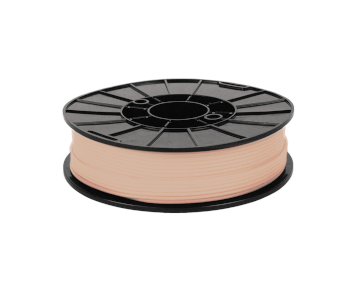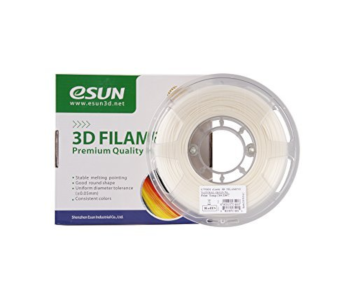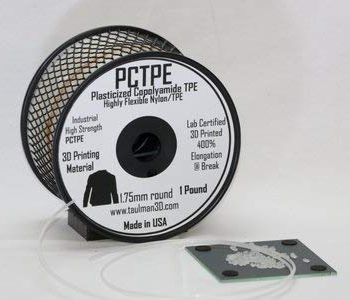Flexible TPE Filament: Properties, How to Use, and Best Brands
One of the ultimate goals of 3D printing is to be able to recreate any 3D model using a variety of materials used in actual industrial and commercial products. Of course, not all of these materials are compatible with 3D printing, but we can use alternatives that mimic them. TPE is an example of an alternative – a flexible filament that has properties similar to rubber.
Flexible filaments can be quite a handful to deal with, but the results are usually worth it. The same can be said for TPE. What are the best printer settings so that you can make the most out of your TPE filament? What are the best TPE filaments that you can buy today?
What is TPE?
TPE stands for Thermoplastic Elastomer, which is a catch-all term for a group of plastics that exhibit rubber-like properties. Not only is TPE very flexible, but it also has impressive impact resistance and non-slip features. Basically, it mimics almost all of the desirable properties of rubber in a form that can be melted and extruded in a 3D printer.
There may be some confusion between TPE and another flexible filament, TPU, or thermoplastic polyurethane. Technically, TPU is just another type of TPE. After all, TPE is a non-specific term for a broad range of flexible polymers. In the parlance of 3D printing, however, TPU is normally used to refer to a filament that’s a bit more rigid than TPE.
These two terms can still be used interchangeably by different filament brands. To check if you’re buying the type of filament that you need, it’s best to check for the filament’s hardness rating. TPE is more flexible (and a little harder to work with), so anything rated at below 90A hardness can be considered TPE.
Properties of TPE
1. Flexible
Soft TPE is the filament material that most closely simulates the softness of real rubber. A print made with TPE can be squished to a very small size and stretched to twice its length and still be able to revert to its original size and shape with no damage.
Flexibility may be a highly desirable trait of a finished print, but it can also make TPE a very challenging filament to work with. As we’ll discuss in more detail later, the extreme flexibility and softness of TPE are two of the reasons why it continues to become overshadowed by its slightly more rigid counterpart, TPU.
2. Durable and impact-resistant
TPU is an extremely hardy material that can deform under sudden or sustained impact and revert to its original dimensions without damage. This makes TPE an excellent material for functional parts that regularly sustain impact, vibration, and abrasion.
3. High friction coefficient
Just like rubber, a print made with TPE comes out with an innately non-slip surface. This makes TPU an excellent choice for linings for containers or mounting sections for ornaments and other household items. One of the most common uses of TPU in 3D printing is for the creation of custom-made phone cases – not only does the non-slip surface keep your phone from sliding around, but TPU also provides excellent impact resistance.
4. Prone to deformation and buckling
The flexibility of TPE is great for finished products, but it can also lead to a lot of headaches during printing. The TPE filament can easily deform or buckle inside the extruder assembly, typically at the filament path from the spool to the extruder and at the nozzle. To avoid this problem, one has to ensure that the filament path is unobstructed and has no sharp turns.
Many 3D printing professionals avoid using Bowden extruders when working with flexible filaments, preferring the simplicity of the filament path in direct drive extruder. Making sure that there is no buckling between the extruder and the nozzle takes a careful refinement of the printing speed and temperature settings.
5. Poor bed adhesion
TPE isn’t exactly known to have excellent layer adhesion, so you might need quite a bit of help to get that first layer to stick to the build platform. A heated print bad is recommended, and you’ll also need to apply some sort of adhesion aid to the bed. Warping can happen, but it’s not as severe with TPE as it is with ABS or Nylon.
6. Prone to stringing
TPE can be very soft and fluid-like when molten, so you can expect a lot of stringing if you’re printing a model with a lot of gaps for the extruder to move across. Again, this is a problem that can be avoided by setting the printing temperature at just the right value. It can also help to enable retraction when printing with TPE – how far and how fast may vary depending on the hardness rating of the filament you’re using.
Best applications for TPE
The flexibility, durability, and ability of TPE to deform without damage are some of its most desired characteristics. All of the applications of TPE leverage upon these properties. Around a standard household, you can use TPE to place non-slip pads at the bases of household items or to make your own anti-slip shower mats. Cellphone cases are some of the most common products made using 3D printed TPE.
The possibilities for TPE use in industrial settings are huge. With TPE filament, manufacturing facilities can customize their own engineering components, giving them an easy way to replace equipment parts. TPE makes great dampeners and stabilizers in equipment that go through a lot of vibration and impact. Seals, liners, and gaskets that are usually made from rubber can also be replaced with TPE. TPE has moderate temperature stability up to 140 °C, so it’s possible to use TPE-printed parts for high-temperature applications.
TPE is a material that has been FDA-approved as safe for food contact. It has been used for spouts in drinking water bottles, toddler cups, and feeding items for babies. It’s also possible to use TPE for medical applications as it can withstand the high temperatures needed during autoclaving. In some instances, TPE has been used as a substitute for latex or silicone in medical instruments and prosthetics.
Printer settings for TPE
TPE prints at somewhat high temperature settings – somewhere between 210 to 230 °C. To avoid warping issues and to enhance bed adhesion, a heated printing bed is recommended at 40 to 50 °C. Avoid allowing the temperature of the heated bed to go up to 60 °C, as it can cause the bed adhesion of the material to diminish. For best results, we recommend using an adhesion aid suitable to a heated bed, such as Kapton tape or hairspray.
Slow printing speed is recommended because of the tendency of TPE to buckle between the extruder and the nozzle. It’s best to start at an extremely low speed setting, like 5 mm/s. You can then increase this gradually as long as you don’t encounter any over-extrusion problems. Still, a maximum setting of 30 mm/s is recommended for any type of flexible filament.
People who use flexible filament for the first time typically run into some degree of stringing. This happens when the molten filament oozes out of the nozzle, creating “strings” of filament where there should be none. TPE and other flexible filaments are especially prone to stringing because of how soft they are.
To avoid stringing, you may have to enable retraction in your 3D printer. Retraction reversed the rotation of the extruder gear, pulling a short segment of the filament to relieve the pressure on the molten plastic at the tip of the nozzle. You may still need to tweak with the settings for retraction speed and distance. If the stringing problem persists, you may also need to further decrease your printing temperature.
Because of how slowly you’ll be printing with TPE, turning off your printer’s cooling fan is recommended to maintain layer-to-layer adhesion.
Best TPE filament brands
If you’re looking for a TPE filament, then you’ll have to settle with the fact that most brands do not make any distinction between TPE and TPU. For the sake of this list, we’re sticking with our technical definition of what a TPE filament is – any flexible filament with a shore A hardness rating of less than 90.
1. Ninjaflex TPU filament

With an 85 A hardness rating, the Ninjaflex TPU filament flies right under our hardness threshold to qualify it as a TPE filament. Given how the NinjaTek brand is one of the more popular brands of 3D printing filaments, it’s not surprising to see them at the top of this list. The quality of the NinjaFlex filament is simply amazing, further complimented by the fact that there’s a huge array of fancy colors available.
NinjaTek claims that the NinjaFlex can stretch to an impressive 660% without wearing or cracking. Its low-tack characteristics reduce some of the problems associated with feeding the filament to the extruder, and it can be printed on a heated bed without any adhesion aid. This is a great effort on the part of NInjaTek to eliminate most of the difficulties associated with using flexible filaments.
2. eSun Elastic TPE 3D Printer Filament

The TPE filament from eSun is a slightly less expensive alternative to NinjaFlex, which exhibits comparable properties. It has a shore A hardness rating of 85 and a 30 MPa tensile strength. It doesn’t have the same resistance of Ninjaflex when it comes to deformation, so you might notice that it stretches just a little easier. eSun doesn’t guarantee that you can print their TPE filament directly on a heated glass bed, so applying a layer of hairspray might be in order.
You can save a few bucks by buying the eSun filament but be ready to go through a printing process that’s a bit more involved. It’s far from impossible to get good results, of course, so there’s no need to be intimidated.
3. Taulman PCTPE Nylon and TPE Co-Polymer Filament

Just from the name, you can deduce that this isn’t your usual TPE filament. PCTPE stands for Plasticized Copolyamide TPE, which is just a fancy way of saying that this filament is made from a copolymer of Nylon and TPE. The co-polymer combines the flexibility of TPE with the superior durability of Nylon, creating a truly unique 3D printing filament.
Taulman recommends PCTPE to be used for cellphone cases, wearable outfits and accessories, and utility and industrial parts. Its unique combination of utility and strength is certainly useful, but it also means that you’ll have to deal with the combined difficulties of working with both TPE and Nylon: a high printing temperature, a high chance of warping, and a filament that is prone to deforming.
The roundup
| Material | TPE (Thermoplastic Elastomer) |
| Applications | Cellphone cases, non-slip pads, anti-slip mats for showers, vibration dampers, pipe gaskets and linings |
| Printing temperature | 210 to 230 °C |
| Bed temperature | 40 to 50 °C |
| Bed adhesion | Kapton tape or hairspray |
| Printing speed | 10 – 20 mm/s |
| Cooling | No cooling necessary |
TPE is one of the more unique 3D printing filaments. Its flexibility easily sets it apart, making it both a difficult material to work with and a very useful and versatile filament. Although its more rigid counterpart, TPU, is much more popular, it’s still nice to know that the TPE version is there for when you need your prints to be just a little softer and more flexible.






I don’t know if you’ve possibly never used TPE or what, but it has some of the strongest layer adhesion of any filament material.